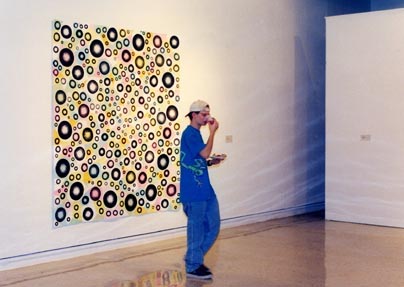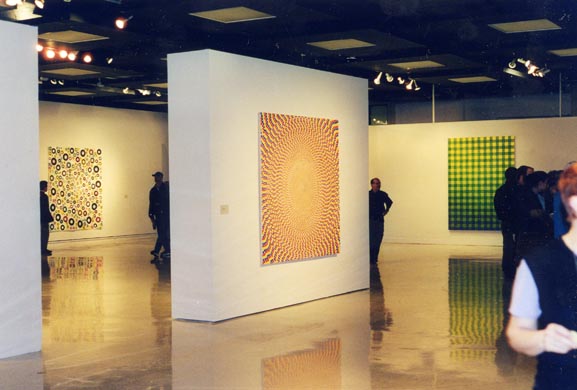
post-hypnotic
University Galleries, Illinois State University
(traveled to Cincinnati Art Center, Atlanta College of Art, Chicago Cultural Center, SECCA, and other venues, 1999 - 2001)
Excerpt from artzine review by Darlene Kryza, Chicago-based writer and artist:
[Around the time of] Pop art, Jean Baudrillard began his intellectual rant about simulacra and hyper-reality, not anticipating how quickly his hypothetical world would arrive. His sociological theories were in direct response to 1950s capitalist America: the replacement of the individual for a shiny new conformist self was odious and frightening. He spoke in depth about the blending of symbols, due to their disproportionate repetition, into meaningless simulacra. Who could have guessed how accurately his predictions would come to fruition? On a formal level, the work in "post-hypnotic" addresses the future of painting: the viewers briskly react to the mirages before them, momentarily entranced, before hastily advancing to the next piece. Feigning disillusionment, the [artists] pull out their most extravagant trickery, hoping to entice viewers long enough to take a closer look, pondering beyond mere patterns in favor of substance.
With a vengeance, Steve Di Benedetto paints a giant yellow Scan, 1989, slapping the viewer with an intricate, precise representation of the moiré pattern created when attempting to digitally scan work that has previously been reproduced. An emotional response occurs as viewers try to get their minds around just how far removed the painting before them is from its original source. Tom Moody, in Jump, 1997 (enlarged view), presents us with his enormous xeroxed paper quilt, commenting on the loss of craftsmanship. He speaks of an era that gauges respect with 24-hour accessibility and the ability to talk fast and smooth. Quite a difference from fifty years ago when respectability existed in the hands of those who could create. The piece also remarks on the lack of patience prevalent in present-day America. Painstakingly constructed, all connections are carefully considered, every shred of commonplace material seamlessly bound.
In the same vein, in Untitled, 1986, Peter Schuyff makes a beautiful yet sad spectacle of the fast-paced nature of contemporary existence, painting a large green and yellow gingham picnic blanket for us. The work feels as if belongs in a historical museum--an artifact of a prior civilization's leisure customs. Bruce Pearson's Wanna Be Happy Be Happy, 1995, reads as a child's botched science experiment. The vivid crayola color and simple organic shapes, naively painted, make the viewer long for the childhood freedom of finger painting. There is such playfulness in his rendering that one cannot help but walk away rejuvenated and reassured. Possibly perceived as an aerial view of a newly constructed subdivision, the cynic could view this piece as identical roads leading to a perfectly manicured central garden of suburban hell.
Excerpt from essay by curator Barry Blinderman, from the exhibition catalog:
[Moody] brings a slightly rumpled materiality to digital media by drawing and printing illusionistically shaded globes of various diameters in a simple 2-D paint program, photocopying them onto colored office paper (the omnipresent blue, canary, goldenrod and pink), cutting around them in the shape of various irregular polygons, and taping them together patchwork style. Fastened unstretched to the wall with pushpins, these subversively appealing paper quilts flaunt lowbrow craft and design, slyly demonstrating both the presaging of the computer matrix in traditional weaving and photoshop "cut-and-paste" technique in simple collage and mosaic.
Photos: Installation views at University Galleries, Normal, IL. Above: Tom Moody, Jump, 1997. Below: Tom Moody, Mark Dagley, Peter Schuyff. (Photos by Mark Dagley)
